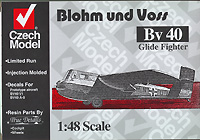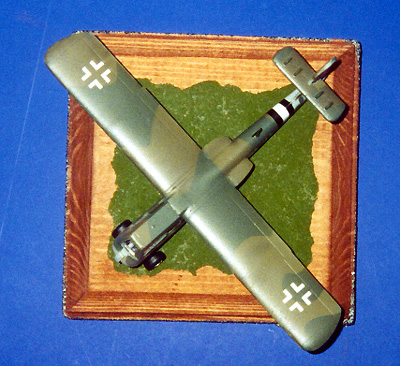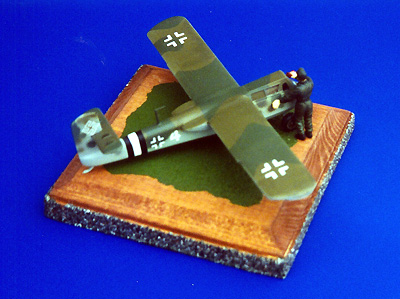
Czech Models 1/48 Bv40 Glider-Fighter
Price: $15.00 retail 1998
Reviewed by: John Lester (onezero@aol.com)
THE AIRCRAFT

Nazi Germany had no shortage of inventive engineers, especially late in the war. By 1944 it seems everyone who could pencil to paper was frantically designing aircraft to turn the tide of battle. Few of these projects made it off the drawing board; even fewer actually flew.
 One that
did was the Bv-40A Glider-Fighter, at least one prototype of which was built
and flight tested. A single-place, high-wing monoplane, it was armed with
two 30mm cannon in pods under the wing. Every effort was made to reduce the
glider's size and cross section; the "real life" result was no longer than
my Dodge Ram pickup. The pilot lay prone in a narrow, cramped cockpit, and
to save weight, drag and space landing gear was replaced by a detachable
trolley and landing skid (much like the Me163). The glider was supposed to
be towed aloft by a conventional fighter to a point ahead of and above an
incoming bomber stream. When released, the pilot would dive through the formation
wreaking destruction, his tiny size and high speed making it (in theory)
nearly impossible for enemy gunners to target him.
One that
did was the Bv-40A Glider-Fighter, at least one prototype of which was built
and flight tested. A single-place, high-wing monoplane, it was armed with
two 30mm cannon in pods under the wing. Every effort was made to reduce the
glider's size and cross section; the "real life" result was no longer than
my Dodge Ram pickup. The pilot lay prone in a narrow, cramped cockpit, and
to save weight, drag and space landing gear was replaced by a detachable
trolley and landing skid (much like the Me163). The glider was supposed to
be towed aloft by a conventional fighter to a point ahead of and above an
incoming bomber stream. When released, the pilot would dive through the formation
wreaking destruction, his tiny size and high speed making it (in theory)
nearly impossible for enemy gunners to target him.
An interesting theory ... but like so many other, never tested in combat. The one (there may have been two, I forget) prototype was captured by the Allies before it had much of a chance to be used.
THE MODEL
Czech Models' kit is fairly standard Eastern European limited-run injection molding. There aren't that many parts; what you get is typical medium grey styrene with finely engraved panel lines and petite details, a little bit of flash and huge attachment points to the sprue. What makes the kit is the True Details resin replacements. A detailed cockpit, gun pods, flattened tires (but thankfully not bulged), battery compartment and landing skid/take off trolley are all crisply molded and cleanly cast in TD' s typical tan resin. A one page fold out instruction sheet/paint guide and decals for two machines (prototype and hypothetical service aircraft) round out the kit.
ASSEMBLY
Building this model is straightforward ... or at least it should be. Even someone building their first limited-run kit should be able to finish it over a weekend. Me, however .... everything that could go wrong, did. This was one of my most trying, least satisfying projects - and it had nothing to do with the quality of the kit. Ah, well.
I started of painting and detailing the cockpit. I painted the interior RLM
02  (Grey) with tan pilot couch (all paints I used were from the Testor's Model
Master enamel line). The instrument panel was painted flat black with bezels
highlighted silver and instrument gauges picked out in white. The stick got
a black grip and Aluminum shaft; seat belts became Radome Tan with Aluminum
hardware. The finished cockpit was inserted into place ant the fuselage halves
glued together, after which I promptly broke off the top of the stick. (And
it was a royal pain to get back together too, let me tell you). I could not
get the resin fuselage brace (which sits under the leading edge of the wing
down around the pilot's calves) to fit - so in the end I left it out.
(Grey) with tan pilot couch (all paints I used were from the Testor's Model
Master enamel line). The instrument panel was painted flat black with bezels
highlighted silver and instrument gauges picked out in white. The stick got
a black grip and Aluminum shaft; seat belts became Radome Tan with Aluminum
hardware. The finished cockpit was inserted into place ant the fuselage halves
glued together, after which I promptly broke off the top of the stick. (And
it was a royal pain to get back together too, let me tell you). I could not
get the resin fuselage brace (which sits under the leading edge of the wing
down around the pilot's calves) to fit - so in the end I left it out.
Czech Models provides two vacuformed canopies. Good thing too, since I screwed the first one up attempting to slice the main part from the windscreen (I was going to position the canopy open - but since I could not find a photo or drawing of how it hinged I would have been forced to keep it closed anyway). The plastic is nice and clear, and looks appropriately glass-like after a dip in Future. Note that the drawings in the instructions show the aft window as clear; the two photos I found of the prototype suggest there was a sliding armored plate there, so I painted over those two windows.
Wings and tail went together without fuss, though I managed to get gluey fingerprints on both. I also managed to put the gun pods under the wrong wings and had to break them off and reattach. <sigh> Only a little putty was needed to fix the gaps. Sanding the join between the rear of the wings and the gun pods proved to be a nightmare for me, though it should not have. I attached the resin battery compartment to the nose, but was so frustrated at this point I did not add the small wire and pitot/venturi tube up front one can see from pictures of the prototype. Finally, I attached the landing skid and masked everything for painting. I left the wheels and trolley axle off until the end. I should have also drilled and added four small holes for the cables that attached to the trolley at this point, but I forgot this step.
 I primed
the model with grey automotive paint, fixed all the flaws I found (there
were a lot, and all my fault), then sprayed as per the colors for the
hypothetical aircraft. (RLM 80/81 over 76). After this had dried, I oversprayed
with Future prior to decalling.
I primed
the model with grey automotive paint, fixed all the flaws I found (there
were a lot, and all my fault), then sprayed as per the colors for the
hypothetical aircraft. (RLM 80/81 over 76). After this had dried, I oversprayed
with Future prior to decalling.
Decals were made by Propagteam - and they at least went on without fuss. they are extremely thin, and can break pretty easily, but I had no problems. The few irregularities were easily smoothed out with MicroSol decal solvent. Another thin coat of Future, followed by a semi-gloss coat (I decided the maintenance folks would have waxed the aircraft to give it every bit of extra speed possible) and I was nearly done.
After pulling off the tape masks from the canopy, and fixing the areas where paint leaked under or pulled up putty, I affixed the tow bar and trolley. The mounting points for the wheels broke off, and I had a heck of a time getting the wheels attached and properly aligned.
Finally, I set the model on a base (the wheels were too fragile after all my clumsiness to trust just sitting on a shelf). I masked off an irregular pattern on a small, stained wooden plaque (50 cents from the local craft store). This I sprayed with Krylon spray adhesive and sprinkled with Microballoons, a ground up foam used with r/c aircraft. this was sprayed three different shades of green in irregular blotches - makes a good looking grass field in this scale. When this had dried, I superglued the model to it.
The last step was adding the mechanic figure, in this case the one included with Monogram's Me 262 kit. I repositioned his hand to conform with the Bv40 canopy and painted per Monogram's directions.
All in all - not a bad model. I just wish I'd done a better job at it.
Copyright ModelingMadness.com

Back to Reviews Page 2020